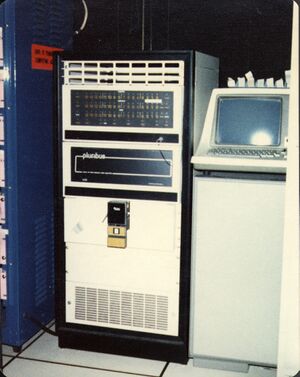Interface Message Processor
The Interface Message Processor (or IMP, as they were universally known) was the packet switch which the ARPANET was made out of; the IMPs were connected to each other via high-speed dedicated point-point telephone links, connected to the IMPs via a modem. All ARPANET hosts connected to an IMP; connection of a host to an IMP required a special network interface, an IMP interface, which used the asynchronous bit-serial 1822 interface standard, which was especially created for the ARPANET.
A message from one Host to another was sent via the source Host's IMP, then routed through some number (possibly zero) intermediate IMPs, then through the destination Host's IMP (possibly the same IMP as the first one, in which case the message never went over a telephone line), on to the destination Host. The protocol which controlled both the channel between the host and IMP, and inter-host communication, was the Host-to-IMP Protocol.
The IMPs were 'ruggedized' Honeywell DDP-516 minicomputers, with added special high-speed modem interfaces, and 1822 host interfaces. Later, other variant minicomputers were also used; the Honeywell DDP-316 (a slower, and presumably cost-reduced, program compatible version of the 516), the Pluribus, and the BBN C/30 (which first had microcode which emulated the Honeywell machines; later an updated "native mode" microcode exposing the full 20-bit hardware).
External links
- Initial Design for Interface Message Processors for the ARPA Computer Network
- Resurrection of the 1973 IMP code - While focused on the retrieval, and running under a simulator, of the original IMP code, this site contains much other IMP-related material too (manuals, etc)
- F.E. Heart, R.E. Kahn, S.M. Ornstein, W.R. Crowther, and D.C. Walden, The interface message processor for the ARPA computer network, Proceedings AFIPS, 1970 SJCC, Vol. 36, pp. 551-567.
- Intermodem Processor System - Honeywell manual covering much of the custom IMP hardware
- The Arpanet IMP Program: Retrospective and Resurrection
- Honeywell Series 16
- Models 316 and 516 Programmers' Reference Manual
- H316-20 Data Multiplex Control Option - DMA controller heavily used by the IMP modem and host interface hardware
- ARPANET Technical Information
- Ruggedized Honeywell 516 ARPANET IMP - "'deep dive' analysis of [some of] the IMP code from the early 1970s"
- IMP,3050,IMP - actual source code listing for the above
- The IMP Lights story - improving the reliability of the IMPs
